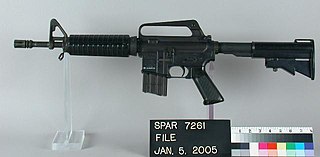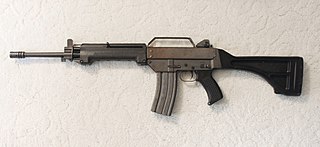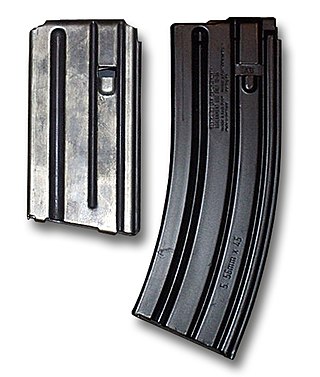
The M16 rifle is a family of assault rifles adapted from the ArmaLite AR-15 rifle for the United States military. The original M16 rifle was a 5.56×45mm automatic rifle with a 20-round magazine.

The SA80 is a British family of 5.56×45mm NATO service weapons used by the British Army. The L85 Rifle variant has been the standard issue service rifle of the British Armed Forces since 1987, replacing the L1A1 Self-Loading Rifle. The prototypes were created in 1976, with production of the A1 variant starting in 1985 and ending in 1994. The A2 variant came to be as the result of a significant upgrade in the early 2000s by Heckler & Koch and remains in service as of 2024. The A3 variant was first issued in 2018 with several new improvements.

Bolt-action is a type of manual firearm action that is operated by directly manipulating the bolt via a bolt handle, most commonly placed on the right-hand side of the firearm. The majority of bolt-action firearms are rifles, but there are also some variants of shotguns and handguns that are bolt-action.

In firearms terminology, an action is the functional mechanism of a breechloading firearm that handles the ammunition cartridges, or the method by which that mechanism works. Actions are technically not present on muzzleloaders, as all those are single-shot firearms with a closed off breech with the powder and projectile manually loaded from the muzzle. Instead, the muzzleloader ignition mechanism is referred to as the lock.

The Colt AR-15 is a product line of magazine-fed, gas-operated, autoloading rifle manufactured by Colt's Manufacturing Company ("Colt") in many configurations. The rifle is a derivative of its predecessor, the lightweight ArmaLite AR-15, an automatic rifle designed by Eugene Stoner and other engineers at ArmaLite in 1956.

The Steyr AUG is an Austrian bullpup assault rifle chambered for the 5.56×45mm NATO intermediate cartridge, designed in the 1960s by Steyr-Daimler-Puch, and now manufactured by Steyr Arms GmbH & Co KG.
The La France M16K is an M16 rifle modified by the company La France Specialties, which among with other firearm-related activities, convert common military weapons into more compact configurations typically for law enforcement and special forces use.

The Colt Automatic Rifle-15 or CAR-15 is a family of M16 rifle–based firearms marketed by Colt in the 1960s and early 1970s. However, the term "CAR-15" is most commonly associated with the Colt Commando ; these select-fire carbines have ultrashort 10.5-inch (270 mm) and 11.5-inch (290 mm) barrels with over-sized flash suppressors.
The ArmaLite AR-18 is a gas-operated rifle chambered for 5.56×45mm NATO ammunition. The AR-18 was designed at ArmaLite in California by Arthur Miller, Eugene Stoner, George Sullivan, and Charles Dorchester in 1963 as an alternative to the Colt AR-15 design, a variant of which had just been selected by the U.S. military as the M16. A semi-automatic version known as the AR-180 was later produced for the civilian market. While the AR-18 was never adopted as the standard service rifle of any nation, its production license was sold to companies in Japan and the United Kingdom, and it is said to have influenced many later weapons such as the British SA80, the Singaporean SAR-80 and SR-88, the Belgian FN F2000, the Japanese Howa Type 89 and the German Heckler and Koch G36.

A breechblock is the part of the firearm action that closes the breech of a breech loading weapon before or at the moment of firing. It seals the breech and contains the pressure generated by the ignited propellant. Retracting the breechblock allows the chamber to be loaded with a cartridge.

Gas-operation is a system of operation used to provide energy to operate locked breech, autoloading firearms. In gas-operation, a portion of high-pressure gas from the cartridge being fired is used to power a mechanism to dispose of the spent case and insert a new cartridge into the chamber. Energy from the gas is harnessed through either a port in the barrel or a trap at the muzzle. This high-pressure gas impinges on a surface such as a piston head to provide motion for unlocking of the action, extraction of the spent case, ejection, cocking of the hammer or striker, chambering of a fresh cartridge, and locking of the action.

Rotating bolt is a method of locking the breech of a firearm closed for firing. Johann Nicolaus von Dreyse developed the first rotating bolt firearm, the "Dreyse needle gun", in 1836. The Dreyse locked using the bolt handle rather than lugs on the bolt head like the Mauser M 98 or M16. The first rotating bolt rifle with two lugs on the bolt head was the Lebel Model 1886 rifle. The concept has been implemented on most firearms chambered for high-powered cartridges since the 20th century.

The Leader T2 MK5 Series firearms were chambered for the 5.56×45mm NATO cartridge and manufactured by Leader Dynamics of Smithfield, NSW, Australia (1978-1982/1983). The Leader was the brainchild of British weapons designer Charles St. George. It was originally a contender for a 5.56 mm Australian military service rifle to replace the then-issued Lithgow L1A1 SLR and Colt M16A1 rifles. What was unique about this endeavor was that Australia had never designed or manufactured its own commercial gas-operated semi-automatic rifle. The rifle was abandoned when the Steyr AUG was adopted for use by the Australian military.
The Colt Automatic Rifle or Colt Light Machine Gun is a 5.56 mm NATO, open-bolt, full-automatic-only firearm developed by Colt Defense. It is based on the M16A2/A4, and has a distinctive squared-off handguard, vertical grip, carrying handle and integrated bipod.

The Heckler & KochG41 is a German 5.56×45mm NATO assault rifle introduced in 1981 and produced in limited quantities by Heckler & Koch. It was designed to replace the 7.62×51mm NATO chambered Heckler & Koch G3 and the G3 based .223 Remington/5.56×45mm and later 5.56×45mm NATO chambered Heckler & Koch HK33 service rifles providing a more modern weapon compatible with then recently introduced NATO standards. It can use both the then new STANAG 4172 compliant 5.56×45mm NATO SS109, SS110, and SS111 ammunition and older .223 Remington/5.56×45mm M193 ammunition and was the last Heckler & Koch service rifle designed around the roller-delayed blowback mechanism.

The Vepr is the first Ukrainian-made assault rifle, designed in 1993–1994 by the State Space Agency of Ukraine and announced in 2003. It is one of several bullpup conversions of the conventional Russian AK-family design, along with the Polish Kbk wz. 2005 Jantar, the Chinese Norinco Type 86S, the Russian OTs-14 Groza and the Finnish Valmet M82.

The cocking handle, also known as charging handle or bolt handle, is a device on a firearm which, when manipulated, results in the bolt being pulled to the rear, putting the hammer/striker into a spring-loaded ("cocked") "ready and set" position, allowing the operator to open the breech and eject any spent/unwanted cartridge/shell from the chamber, and then load a new round from the magazine or belt if required. By opening the breech, it also helps the operator to verify that the weapon's chamber is clear of any rounds or other obstructions; to clear a stoppage such as a jam, double-feed, stovepipe or misfire; to facilitate moving the bolt back into battery, acting as a forward assist ; and to release a bolt locked to the rear by a catching mechanism on a firearm equipped with a "last round bolt hold open" (LRBHO) feature.

A STANAG magazine or NATO magazine is a type of detachable firearm magazine proposed by NATO in October 1980. Shortly after NATO's acceptance of the 5.56×45mm NATO rifle cartridge, Draft Standardization Agreement (STANAG) 4179 was proposed in order to allow NATO members to easily share rifle ammunition and magazines down to the individual soldier level. The U.S. M16 rifle's magazine proportions were proposed for standardization. Many NATO members, but not all, subsequently developed or purchased rifles with the ability to accept this type of magazine. However, the standard was never ratified and remains a "Draft STANAG".

The Bushmaster M17S is a semi-automatic bullpup rifle that was manufactured by Bushmaster Firearms International from 1992 until 2005.
The STG-556 is a Steyr AUG clone formerly manufactured by Microtech Small Arms Research (MSAR). It was available in civilian and military/law enforcement (select-fire) variants.
















